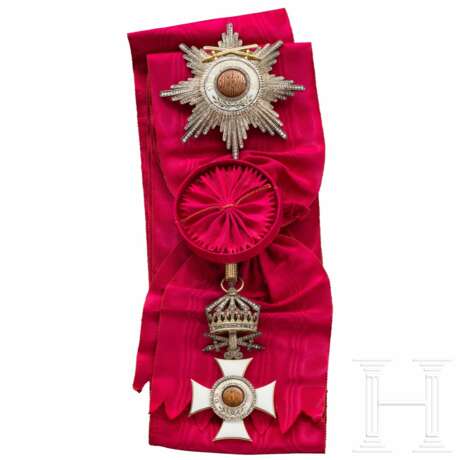Wilhelm Freiherr von Leonrod - Großkreuzsatz mit Schwertern am Ring und Brillanten des bulgarischen St.-Alexander-Ordens, im Verleihungsetui, mit Überkarton
07.05.2024 10:00UTC +01:00
Classic
Vendu
35000EUR € 35 000
| Auctioneer | Hermann Historica |
|---|---|
| Lieu de l'événement | Allemagne, Grasbrunn / München |
| Commission | 25 % |
Archive
La vente aux enchères est terminée. Vous ne pouvez plus enchérir.

ID 1196545
Lot 4006 | Wilhelm Freiherr von Leonrod - Großkreuzsatz mit Schwertern am Ring und Brillanten des bulgarischen St.-Alexander-Ordens, im Verleihungsetui, mit Überkarton
In Gold gefertigtes Ordenskreuz aus der Regierungszeit Zar Ferdinands I. (1861 - 1948) von 1908 bis 1918, weiß und transluzid rot emailliert. Das rote Zentrum mit der altkyrillischen Inschrift "St. Alexander" von Brillantrosen (in Silber gefasst) umgeben, der Schriftreif "Gott mit Uns" und die Zieragraffe mit à jour-gefassten Brillantrosen eingefasst bzw. besetzt. Die aus vergoldetem Silber gefertigte Kronenüberhöhung des eckigen Typs (ab der Ausrufung zum Königreich (Zarentum) 1908) rückseitig emailliert (Kronreif zusätzlich grün), im Avers mit Steinbesatz (Altschliff-Diamanten, Brillantrosen), im Kronreif zusätzlich Saphire und Rubine, meist à jour-gefasst. Die Kronenhaube im Inneren beidseitig handziseliert und transluzid emailliert. Als bewegliches Verbindungsglied zum Kreuzkörper das flach gekreuzte Schwerterpaar (mehrteilige Parierstangen) in Ringbindung (rückseitig Revisions-Scharnieröffnung) aus vergoldetem Silber, gänzlich mit à jour-gefassten Altschliff-Diamanten besetzt. Der Bandring (wohl Gold) inseitig mit der Herstellerangabe "C. F. ZIMMERMANN HOFJUWELIER PFORZHEIM" gepunzt. Breite 51,8 mm. Gewicht 49,1g.
Der achtstrahlige Bruststern komplett (jeder Strahl) mit Altschliff-Diamanten in à jour-Fassung besetzt, die Rückseite vergoldet, an Nadel mit der Herstellerangabe "C. F. ZIMMERMANN HOFJUWELIER PFORZHEIM". Das weiß und transluzid rot emaillierte Medaillon außen von Altschliff-Diamanten, innen von Brillantrosen umgeben, das gekreuzte Schwerterpaar in Gold gefertigt und mittels dreier Hohlnieten am Sternkörper befestigt. Breite 91,5 mm. Gewicht 74,4 g.
Zusammen mit der hellroten, mit Rosette konfektionierten Ordensschärpe im weinroten Samt-Verleihungsetui mit aufgelegter, teilemaillierter Zarenkrone aus vergoldetem Silber und im weißen, goldbedruckten (u.a. mit bekrönter Initiale Zar Ferdinands I.) Überkarton (kleine Einrisse der Deckelkanten).
Prachtvolles, in höchster Juwelierskunst geschaffenes Ordens-Ensemble!
Die Verleihung der Schwerter am Ring zum bulgarischen Alexander-Orden war ab 1886 möglich. Ausgezeichnet wurden Offiziere in Kriegszeiten, die nicht unmittelbar vor dem Feind standen. Verleihungen "in Brillanten" erfolgten aufgrund besonderen Wohlwollens des Zaren (vgl. Bretzendorfer/Kuhn 2008).
Leider sind uns keine dezidierten Verleihungszahlen der bulgarischen Ordensgrade überliefert. Es handelt sich bei dieser hervorragenden Ordensgarnitur um die einzige uns in dieser Ausführung bekannte!
Wilhelm Freiherr von Leonrod (1865 - 1943) war während des 1. Weltkriegs als Obersthofmeister des letzten bayerischen Königs im Zentrum der Macht. Insgesamt wurden ihm 15 Großkreuzsätze verliehen.
Wilhelm Freiherr von Leonrod – a Grand Cross set with Diamonds and Swords on the Ring of the Bulgarian Order of St. Alexander in the presentation case, including the outer box
Wilhelm Freiherr von Leonrod – a Grand Cross set with Diamonds and Swords on the Ring of the Bulgarian Order of St. Alexander in the presentation case, including the outer box
Wrought in gold and enamelled in white and translucent red, the order cross dates from the reign of Tsar Ferdinand I (1861 – 1948) from 1908 to 1918. The red centre inscribed "St. Alexander" in ancient Cyrillic, surrounded by diamond roses (in a silver setting), the inscription ring reads (tr.) "God with us" and the decorative riband buckle with diamond roses set à jour. The angular-type crown surmounting made of gilt silver, issued when Bulgaria was proclaimed a Kingdom (Tsardom) in 1908, enamelled on the reverse (the circlet also in green enamel), the obverse embellished with gemstones (old-cut diamonds, diamond roses), plus sapphires and rubies in the circlet, most set à jour. The cap of the crown hand-chased on both sides of the interior and covered in translucent enamel. The flat, crossed pair of swords (with multi-piece quillons) serve as the movable connecting element to the body of the cross in a gilt silver ring binding (a hinged inspection opening on the back), completely covered with old-cut diamonds, set à jour. The suspension ring, presumably gold, stamped on the inside with the manufacturer "C. F. ZIMMERMANN HOFJUWELIER PFORZHEIM". Width 51.8 mm. Weight 49.1 g.
Each ray of the eight-rayed breast star encrusted with old-cut diamonds, set à jour, the reverse gilt, an a pin stamped with the manufacturer "C. F. ZIMMERMANN HOFJUWELIER PFORZHEIM". The medallion enamelled in white and translucent red, enclosed by a border of old-cut diamonds on the outside and diamond roses on the inside, the crossed pair of gold swords fastened to the body of the star with three hollow rivets. Width 91.5 mm. Weight 74.4 g.
Together with the pale red order sash, customised with a rosette, in the presentation case of burgundy velvet, with an appliquéd, partly-enamelled tsarist crown in gilt silver and in the white, gold-embossed outer box (including the crowned initials of Tsar Ferdinand I), the edges of the lid slightly torn.
A magnificent order set, wrought with consummate jeweller's craftsmanship.
The Swords on the Ring distinction was introduced for the Bulgarian Order of St Alexander as of 1886. It was designed to honour officers in times of war who did not encounter the enemy directly. The "Diamonds" were awarded as a token of the tsar's exceptional goodwill (see Bretzendorfer/Kuhn 2008).
Unfortunately, no reliable records are available on the number of bestowals of the Bulgarian order grade. To our knowledge, this brilliant order set is the only one of this issue in existence.
Wilhelm Freiherr von Leonrod (1865 - 1943), Lord Chamberlain to the last Bavarian King, was in the centre of power during World War I. In total, he was awarded 15 Grand Cross sets.
Condition: I -
| Adresse de l'enchère |
Hermann Historica Bretonischer Ring 3 85630 Grasbrunn / München Allemagne | ||||||||||||||
|---|---|---|---|---|---|---|---|---|---|---|---|---|---|---|---|
| Aperçu | |||||||||||||||
| Téléphone | +49 (0)89 5472 649 0 | ||||||||||||||
| Fax | +49 (0)89 5472 64999 | ||||||||||||||
| Commission | 25 % | ||||||||||||||
| Conditions d'utilisation | Conditions d'utilisation | ||||||||||||||
| Heures d'ouverture | Heures d'ouverture
|


